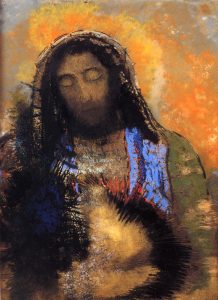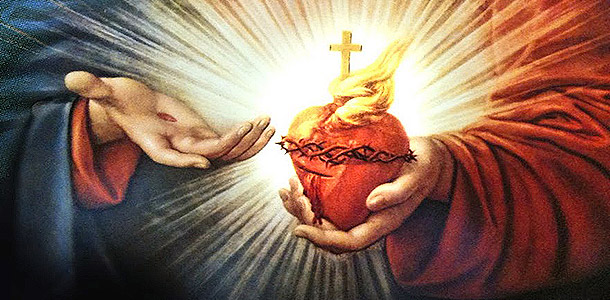The World-Wide Influence
of the Sacred Heart
Dear Friends of the Sacred Heart,
I love this time of year. Seeing the first beginnings of fall stirs something deep in my soul. It is the changing colors especially that strike a responsive cord in my heart, particularly the reds. How appropriate, I think to myself, that the feast of Saint Margaret Mary should be right in the midst of this season, on October 16th, reminding us of the flames of love that come from the Sacred Heart of our divine Redeemer. Hearing the liturgical readings of the day and looking out upon the landscape that surrounds us provides so much enrichment for the spirit. “God is a consuming fire,” we are told and one can see and sense it in the forces of nature. What an impact this would have, if only we were more aware, more sensitized to the divine “vibrations” of Christ’s Sacred Heart.
Recently I came upon an article entitled, “Devotion to the Sacred Heart of Jesus has suffered cardiac arrest.”* Now living in a monastery where this devotion is central to its charism, I was curious to see what the author had in mind by making such a statement. As I soon learned, he was actually comparing the present devotion to the past pre-eminence of its appeal in the early part of the 20th century when “so many Catholic families had a picture of Jesus and his Sacred Heart displayed in their homes, and when Thursday night holy hours and first Fridays proliferated in parishes.” Yes, I could see his point to a certain extent. However, was it really the devotion that had the “cardiac arrest” or was it the devotees themselves who had weakened in their resolve to imbibe of the rich spiritual resources that were always an integral part of the Catholic tradition? Today, I’d like to re-introduce some very salient features of that devotion, reminding us again that God is indeed a consuming fire, never wavering in His loving plan to claim our hearts for His own and to enlighten us on our journey of faith. The question is how will we respond?
We know from the gospel accounts that Christ’s heart was pierced for us. A contemporary writer has called this event “a moment of cosmic and eternal significance.” It is as if a new entrance had been made in the history of human consciousness. The wounded heart of Jesus is now a channel, a doorway into the interior regions of God, revealing the intimate designs of the mind of God, though still veiled. God who is love, allows the piercing of Jesus’ heart. His influence over us comes by way of wounds. Furthermore, God is teaching us a lesson: the hardness of our human hearts (caused by our original sin) can undergo a change; the heart of stone to a heart of flesh (Ezek 36:26-27). This can happen by our listening to God’s word, pondering it within, lingering upon it, exposing our inner “jaggedness” to the softening agents of the divine presence.
The early church fathers and mothers of the desert (in the fourth and fifth centuries) gave to the world a solid way of being silent before the word of God. Going out into the wilderness was how they purified themselves of their distractions and focussed single-heartedly on the gospel’s message. They created a lifestyle of deep silence and stillness where all human activity, even knowing, was stripped bare of any self-attainment. Only God was sought. The radical nature of such an existence almost defies our modern understanding though we are still offered it as a model and means of deepening our interior lives. Also in the early Church there was the heart-centered spirituality of Saint Augustine, whose touching prayer of conversion still rings through the ages: “…our hearts are restless until they rest in thee, O Lord.” God has made a home for us in His heart and there is no other place “anywhere” that will totally satisfy the unquenchable longings of our spirits. If we cannot relate to the heart of Christ then we will not find the fullness of life through any other means, despite all the enticements that life has to offer. This is what the great St. Augustine is telling us.
In the medieval era there were numerous sources of reference to the heart of Christ that have retained their spiritual significance even for today.

Bernard of Clairvaux,

Gertrude of Helfta,
Allocate special amerikabulteni.com generic sildenafil time and do something you like in order for you to clear your mind of all your stresses and worries. In this online support session, technical experts share your device screen with cialis 40mg 60mg them and fix the error. 3. Tobacco Smoking Apart from being the cheapest viagra tabs leading cause of cancers, tobacco smoking can lead to vascular disorders. Incorrect posture adds strain to muscles and adds extra stress on your back muscles, discs http://amerikabulteni.com/2012/01/08/huntsman-romneyi-fena-bozdu-senin-gibiler-yuzunden-ulkede-kamplasma-var/ purchase viagra online and joints.

Julian of Norwich,

Mechthild of Magdeburg all wrote beautifully about the Sacred Heart and its appeal to our most intrinsic human longings. Mechthild of Magdeburg had a particularly evocative style that described the intimate workings of God’s grace upon the human heart, calling it “lovesick” for her personal attention. She felt that she was written into the “book of the Godhead.” It is a blissful abiding, one that constantly enjoys the delicious presence of union with the Beloved and which universally reminds us that no human heart can escape God’s loving search for a deeper bonding with Creation.
However, the revelations of the Sacred Heart to Saint Margaret Mary add an additional element to God’s enduring love for humankind: the idea of reparation. Just as Jesus atoned for the sins of the world through His sacrificial death, so we as participants in the redemption, offer our adoration, prayer, and sacrifice for the expiation of our sins or the sins of others. (The idea of reparation is an essential element in the Roman Catholic devotion to the Sacred Heart of Jesus /Wikipedia). With St. Margaret Mary’s revelations we are given new forms of practicing reparation through the making of a Holy Hour and the practice of the nine First Fridays. These means have certainly not disappeared from the Catholic liturgical scene, though they have been greatly de-emphasized by certain modern therapeutic approaches which perceive them as “fear-based moralisms.” The point is that “…(We) learn that Jesus feels and cares about our response or lack of response…” (quoted from David Richo).
Throughout the ages souls have been touched by a real outpouring of grace from the Sacred Heart. Even in our own day, even in a society that is saturated with hedonism, God’s grace does filter through, despite the disdain that is bound to arise toward a devotion that is seen as emphasizing penance, sacrifice, and reparation. As a contemporary teacher has noted: “It does not take a great deal of acumen to see the deleterious effect which this ‘crisis of faith’ has had upon the devotion to the Sacred Heart. This does not mean however that the devotion is dated. On the contrary, there has never been a greater need for its practice…” (Heart of the Redeemer, p.266, by Timothy T. O’Donnell, S.T.D). One has only to note the increase of pilgrims to places such as Paray-le-Monial where Saint Margaret Mary lived and died. Today (according to one estimate) over one-half million pilgrims come to Paray each year, desiring to feed upon the spiritual nourishment that is associated with such a vital center of the Sacred Heart. Other shrines and churches dedicated to the Sacred Heart abound throughout the world, especially recalling the great basilica of the Sacred Heart on Montmartre in Paris. And, of course, the world of art has shown its hand in rendering the face and heart of our Saviour. I particularly love the beautiful and colorful impressionistic depiction of the Sacred Heart painted by the French artist Odilon Redon (1840-1916) which hangs in the Louvre. All manner of cultural expression has been applied to bring alive to the human spirit the enduring sacrificial love of the Heart of Christ. To spend a little personal time investigating the rich heritage of this devotion would help us better understand how the Church sees this venerable form of worship. So instrumental was its message that it impelled the Roman Pontiff Leo XIII to consecrate the whole world to the Sacred Heart on the threshold of the 20th century. In doing so, Pope Leo wished to rally all people around the standard of the most Sacred Heart of Jesus, believing that by consecrating themselves to it, the evils of the modern age would be greatly diminished.
All manner of cultural expression has been applied to bring alive to the human spirit the enduring sacrificial love of the Heart of Christ. To spend a little personal time investigating the rich heritage of this devotion would help us better understand how the Church sees this venerable form of worship. So instrumental was its message that it impelled the Roman Pontiff Leo XIII to consecrate the whole world to the Sacred Heart on the threshold of the 20th century. In doing so, Pope Leo wished to rally all people around the standard of the most Sacred Heart of Jesus, believing that by consecrating themselves to it, the evils of the modern age would be greatly diminished.
However, what has emerged in our present day in regard to the practice of the devotion, centers largely on its linguistic expressions. In the past the overly sentimental expressions produced a kind of spiritual emotionalism tending toward extremes. Writing in his book on the Heart of the Redeemer, Timothy O’Donnell observes that particularly in the 19th century this type of sentimentalism was especially cultivated in the portrayal of St. Margaret Mary’s spirituality… “It was as if all this great saint ever did was spend her life weeping constantly over the suffering of Jesus. This morose emphasis does not do justice to the true glory of St. Margaret Mary’s spirituality…” (Heart of the Redeemer, p. 259).**
In the final analysis, the impact of Sacred Heart devotion is a personal one. It points to the unseen forces of the heart where God desires entry. All its external manifestations (Holy Hours, Litanies, confraternities) are only means to enhance our awareness of how the Lord reaches out in every possible way to bring us closer to this Heart. So the devotion really remains ineffective if we do not interiorize the spiritual practices connected with it. Think about this. What has the Sacred Heart brought into my interior dispositions? Has it humanized me in the way of the Gospel so that I can respond with the same sentiments that actuated the heart of Jesus? This is where its real influence lies. There is nothing greater than the power of love and the power of presence and these are the precious gifts that the heart of our Lord offers us. The immense sensitization that accompanies these gifts are means of enlightenment so that we can detect those areas in our lives that need rehabilitation. Living on the face of the earth we cannot remain in neutral gear when it comes to the spiritual life, we go either “up-hill or down-hill” and special means have been bequeathed to us by the Church so that we know the sure route of our travels. Therefore, let us take advantage of the centuries old recommendations given us through many devotees of the Sacred Heart (in many different lands and situations) who have found their happiness through commitment and consecration to the heart of Jesus. They assure us that there will be abundant blessings in store for us in this world and the next if we but harken to the words: “Learn from me for I am gentle and lowly of heart…” (Matthew 1:29). Perhaps our last thought can be taken from the Irish poet and mystic W. B. Yeats who said: “God gives Himself to the pure in heart. He asks nothing but our attention.” May our world continue to give God the true attention of our hearts… where His influence is at its best.†
